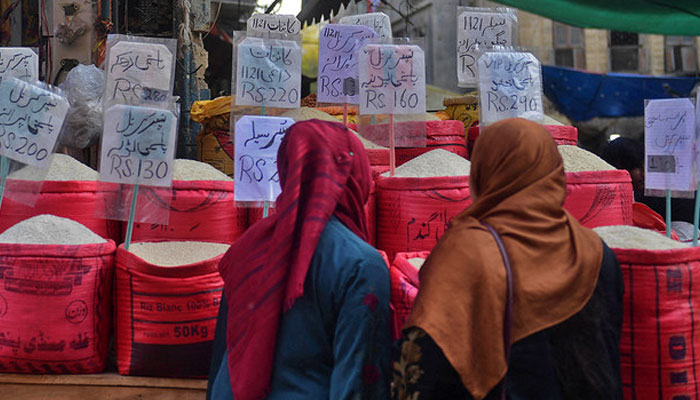Did SBP and IMF get inflation wrong?
Following the onset of post-pandemic inflation in 2021, economists swiftly diverged into two camps
Following the recent approval by the International Monetary Fund (IMF) Executive Board to release the final tranche of SDR828 million (approximately $1.1 billion) under the standby agreement for Pakistan, Deputy Managing Director and Chair Antoinette Sayeh made the following statement: “The State Bank of Pakistan’s tight monetary policy stance remains appropriate until inflation returns to more moderate levels.”
Ms Sayeh, although an experienced professional, lacks a background in macroeconomics, holding a PhD in International Economic Relations. She served as Liberia’s finance minister before joining the IMF in 2008. She has not published research in any notable economic journal and possesses limited experience in the private sector or financial markets.
Her statement reflects the cookie-cutter approach often adopted by the IMF in implementing macroeconomic stabilization programmes. Implicit in her remarks is the assumption that interest rate hikes in Pakistan were the primary driver behind the significant drop in Pakistan’s inflation rate. This assumption suggests that strong aggregate demand was responsible for Pakistan’s highest inflation levels in about fifty years.
Following the onset of post-pandemic inflation in 2021, economists swiftly diverged into two camps: those attributing the inflation to excessive aggregate demand resulting from large recovery packages, and those arguing that the disturbances were transient and self-correcting.
Nobel laureate economist Joseph Stiglitz, in November 2023, published ‘A Victory Lap for the Transitory Inflation Team’, asserting that the “self-correcting” trajectory of car and house prices indicates that inflation was transitory all along. Stiglitz and others posit that the issue lay in supply disruptions, not excessive demand. This perspective suggests that the Federal Reserve’s substantial interest rate increases were not primarily responsible for the inflation slowdown in 2023.
The rise in oil prices by about 40 per cent during the first six months of 2022, following the Russian invasion of Ukraine in February 2022, led to a global inflation surge. This energy price shock and supply disruptions in the post-pandemic world particularly affected energy-importing countries like Pakistan. Although commodity prices, including wheat, initially soared, international wheat prices have since decreased by about 40 per cent from their peak in the spring of 2022.
Pakistan experienced a sudden spike in its year-on-year consumer price inflation (CPI) rate, jumping from 13.8 per cent in May 2022 to 21.3 per cent in June 2022. In June, the CPI rose by 6.34 per cent, with 81 per cent of this increase driven by food, utilities, and transport. Similarly, in October 2022, the CPI increased by 5.1 per cent in just one month, with food prices accounting for 59 per cent of the rise and electricity and gas utilities charges accounting for another 32 per cent.
These examples underscore that inflation in Pakistan was not due to a surge in demand for food items or home utilities but was driven by supply-side factors and higher energy prices.
Pakistan’s annual average inflation rate surged to 21.32 per cent in June 2022 from 9.65 per cent in just twelve months. During this period, international oil prices skyrocketed by 66 per cent, contributing to Pakistan’s current account deficit ballooning to $17.5 billion from $2.82 billion in the previous fiscal year. Energy imports accounted for 50 per cent of the increase in the import bill, with an additional 20 per cent attributed to higher imports of medicines due to Covid-19.
In the subsequent twelve-month period (July 2022 to June 2023), Pakistan’s currency depreciated by 44.2 per cent, while the year-on-year inflation rate reached a 50-year record high of 38 per cent in May 2023.
The significant deterioration in the current account balance was primarily a consequence of high energy prices, leading to a substantial decline in foreign exchange reserves and ultimately culminating in a full-blown currency crisis in the summer of 2023. Pakistan’s failure to secure a timely bailout from the IMF, partly due to its insistence on maintaining an artificial exchange rate, exacerbated the currency crisis, bringing the country to a near default.
The State Bank of Pakistan (SBP) raised its policy rate from 12.25 per cent in April 2022 to progressively 17 per cent in January 2023 and to 22 per cent in June 2023, with the most significant increase being the 300 basis points hike in March 2023. This sharp increase came despite the SBP’s comments about the contraction in economic activity made in its January 2023 monetary policy statement:
“Sale volumes of automobiles, POL, and cement declined significantly in December on a y/y and m/m basis. On the production side, the large-scale manufacturing (LSM) output declined by 5.5 per cent in November 2022. Going forward, production cuts by firms and supply constraints could pull LSM growth further down. Moreover, the latest data on cotton arrivals point to lower crop production than anticipated earlier. This could potentially weaken the agriculture sector.”
The escalation in interest rates was not solely motivated by concerns of an overheated economy or robust aggregate demand, as suggested by the SBP’s own statements. Rather, it was either based on an erroneous assessment of the causes of inflation or, more likely, driven by the perceived necessity of rate hikes to secure IMF financing.
Shortly before the March 2023 rate hike, the central bank’s foreign exchange reserves plummeted to $3.8 billion from a comfortable level of $16.4 billion just a year earlier. The fallout from the energy crisis exacerbated by the Ukraine War underscored Pakistan’s vulnerability to oil shocks, reminiscent of the challenges faced in 2008 when oil prices surged to $147 per barrel.
Pakistan secured the IMF’s standby facility in July 2023. Oil prices also stabilised to around $80 per barrel. Consequently, the currency stabilised and the inflation rate began to decline.
The headline inflation typically responds to interest rate hikes with a time lag, often taking 18 to 24 months to subside. Remarkably, Pakistan witnessed a rapid decline in the inflation rate, dropping from 38 per cent in May 2023 to 27.4 per cent in August 2023, then 20.7 per cent in March 2024, and further to 17.3 per cent in April 2024, representing a roughly 20 percentage point decrease in just 11 months.
According to Claudia Sahm, former Fed economist, inflation was a supply, not demand, issue. “If this was all about demand, we would be in trouble. We would be in a situation more like the 1970s.”
Given that Pakistan’s inflation surge was largely a consequence of supply-side factors rather than excessive aggregate demand, and there has been a significant contraction in economic activity and industrial production, Pakistan should make a case to the IMF for a gradual easing of monetary policy and cuts in the policy rate throughout the remainder of the year to facilitate economic recovery from the shocks experienced in 2022-23.
The writer is former head of Citigroup’s emerging markets investments and author of ‘The Gathering Storm’.
-
 Why ‘X’ Is Down? Thousands Report Twitter Outage: Here’s What You Can Do
Why ‘X’ Is Down? Thousands Report Twitter Outage: Here’s What You Can Do -
 Florida Man Held After Alleged Nail-scattering On Busy Intersections
Florida Man Held After Alleged Nail-scattering On Busy Intersections -
 Valeria Nicov: Sean Penn's Athletic Girlfriend Raises Eyebrows With Latest Photos
Valeria Nicov: Sean Penn's Athletic Girlfriend Raises Eyebrows With Latest Photos -
 Sharon Stone Lashes Out At Fellow Award Show Attendees After Stealing Accusations
Sharon Stone Lashes Out At Fellow Award Show Attendees After Stealing Accusations -
 Gwyneth Paltrow Reveals Real Reason She Said Yes To 'Marty Supreme'
Gwyneth Paltrow Reveals Real Reason She Said Yes To 'Marty Supreme' -
 King Charles Says He And Queen Camilla Stand With People Of Ukraine
King Charles Says He And Queen Camilla Stand With People Of Ukraine -
 Ben Affleck Argues In Favour Of His Shirtless Scene In 'The Rip'
Ben Affleck Argues In Favour Of His Shirtless Scene In 'The Rip' -
 Mississippi Postal Worker Arrested After Complaints Of Marijuana Odour In Letters
Mississippi Postal Worker Arrested After Complaints Of Marijuana Odour In Letters -
 Canada, China Lock Initial Trade Deal On ‘EV,Canola’ To Strengthen Ties: What To Expect Next?
Canada, China Lock Initial Trade Deal On ‘EV,Canola’ To Strengthen Ties: What To Expect Next? -
 Melissa Leo On Euphoria Of Winning An Oscar Vs It's Impact On Career
Melissa Leo On Euphoria Of Winning An Oscar Vs It's Impact On Career -
 Meghan Markle, Prince Harry Express 'hope' In Latest Major Statement
Meghan Markle, Prince Harry Express 'hope' In Latest Major Statement -
 Sophie Turner Backs Archie Madekwe As BAFTA Announces Nominees
Sophie Turner Backs Archie Madekwe As BAFTA Announces Nominees -
 Jason Momoa Cherishes Hosting Ozzy Osbourne's Final Gig Ahead Of His Death
Jason Momoa Cherishes Hosting Ozzy Osbourne's Final Gig Ahead Of His Death -
 Real Reason Timothee Chalamet Thanked Kylie Jenner At Awards Revealed
Real Reason Timothee Chalamet Thanked Kylie Jenner At Awards Revealed -
 Will King Charles Attend Funeral Of Prince Philip's First Cousin, Princess Irene?
Will King Charles Attend Funeral Of Prince Philip's First Cousin, Princess Irene? -
 'Furious' Prince William Wants Andrew As Far Away As Possible
'Furious' Prince William Wants Andrew As Far Away As Possible




